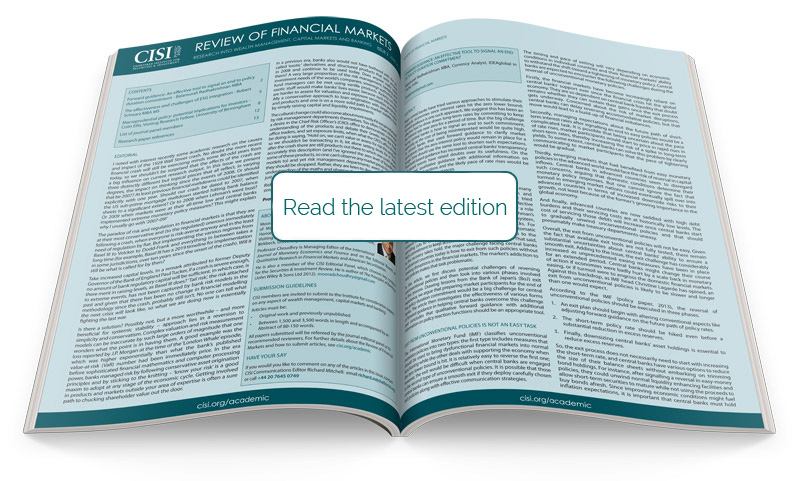Serving growing client demand in climate's other challenges
Extract from introduction by George Littlejohn MCSI
I was privileged to sit through the panels producing the Certificate in Climate Risk just launched by the CISI and our colleagues at the Chartered Banker Institute and Chartered Insurance Institute. In these, it became more apparent as the months went by that the many impacts of the climate challenge and attempts to mitigate it remain uncertain. Scientists are inevitably more conservative even than accountants or actuaries in our sector, but as so often in life, probabilities are the best way to paint true climate pictures. Despite hundreds of years of scientific work, how all of the variables that make weather patterns and ecosystems interact is simply too complex for even the most advanced model or computer to predict infallibly.
For the moment, though, the scientists have done their job, and the task at hand is for financiers to do theirs. Investment clients – both individual and institutional – are moving ahead, and have become more attuned to impact issues, both in their home countries and globally, particularly around the other UN sustainable development goals (SDGs). These encompass areas like health, education, agriculture, renewables, transportation and others.
For the moment, though, the scientists have done their job, and the task at hand is for financiers to do theirs
At a special ‘Ask the Experts goes live: Getting to grips with responsible investment’ session on CISI TV in August 2021, we polled the substantial member audience on this theme, of tradeable impact vehicles, and others. The results show how SDG issues beyond climate will loom yet larger on all our agendas over the coming months and years.
Read the latest edition of RoFM for the results.
The birth of the age of debt
Professor Russell Napier has been an adviser on asset allocation to global investment institutions for over 25 years. His latest book, The Asian Financial Crisis 1995–98, published in July 2021 (and from which the following two extracts are taken) on the lessons from the Asian financial crisis of the late 1990s, brings those dramatic years – and the lessons for today’s generation of financiers – to vivid life. Andy Haldane, lately chief economist at the Bank of England, says of the book: “The Asian financial crisis marked the dawn of a new strain of highly virulent crisis that would, in time, come to afflict every advanced economy in the world. This lucid book offers a forensic and compelling account of its source, contours and consequences.”
The view from the rear of the koala
In developments strongly echoed in Asia in the summer of 2021, the final quarter of 1997 brought a severe cash crunch. In the words of the book, “not a penny was to be found”. The story opens on 8 October 1997, when the Ministry of Finance of the government of Indonesia called the International Monetary Fund. This country of almost 200 million people had run out of money. “It was not the only country in Asia that was suddenly on the verge of bankruptcy. A financial feast had turned to famine in just a few months.”
A confused AML risk management framework haunts European institutionsKarel Lannoo, CEO of the Centre for European Policy Studies (CEPS), and his co-rapporteur Richard Parlour of Financial Markets Law International, a regular contributor to CISI on financial crime, continue their series on anti-money laundering, drawing on their January 2021 report
Anti-money laundering in the EU: time to get serious, by CEPS, one of the world's leading think tanks.
The Fourth Industrial Revolution: incubate and branch outIn March 2021, the CISI published, alongside our friends at the Astana International Financial Centre (AIFC), a free volume for members titled Leapfrogging sustainability, which gazes beyond the pandemic and the climate threat. Distinguished contributors - from AIFC itself, the European Bank for Reconstruction and Development, IE Business School in Madrid, and the University of Cambridge, amongst others – probed the frontiers of finance. The book was accompanied by a series of webinars available now on MyCISI:
- Leapfrogging sustainability: Seven megatrends that are shaping sustainable economic development (May 2021)
- The circular economy: Extending the competitive advantage period of natural resource-rich countries (May 2021)
- Financing the sustainable energy transition: The role of financial centres (June 2021)
- The ultimate endgame: The Eurasia renewable energy internet (June 2021)
- Leapfrogging sustainability: The role of financial centres to de-risk FDI projects (July 2021)

Download the Review of Financial Markets
 October 2021 edition
October 2021 edition
 June 2021 edition
June 2021 edition
 February 2021 edition
February 2021 edition
 October 2020 edition
October 2020 edition
 June 2020 edition
June 2020 edition
 February 2020 edition
February 2020 edition
 October 2019 edition
October 2019 edition
 July 2019 edition
July 2019 edition
 Q1 2019 edition
Q1 2019 edition
 Q3 2018 edition
Q3 2018 edition
 Q2 2018 edition
Q2 2018 edition
 Q1 2018 edition
Q1 2018 edition
 Q4 2017 edition
Q4 2017 edition
 Q3 2017 edition
Q3 2017 edition
 Q2 2017 edition
Q2 2017 edition
 January 2017 edition
January 2017 edition
 September 2016 edition
September 2016 edition
 July 2016 edition
July 2016 edition
 March 2016 edition
March 2016 edition
 December 2015 edition
December 2015 edition
 September 2015 edition
September 2015 edition
 June 2015 edition
June 2015 edition
 March 2015 edition
March 2015 edition
 December 2014 edition
December 2014 edition
 September 2014 edition
September 2014 edition
 June 2014 edition
June 2014 edition
 March 2014 edition
March 2014 edition